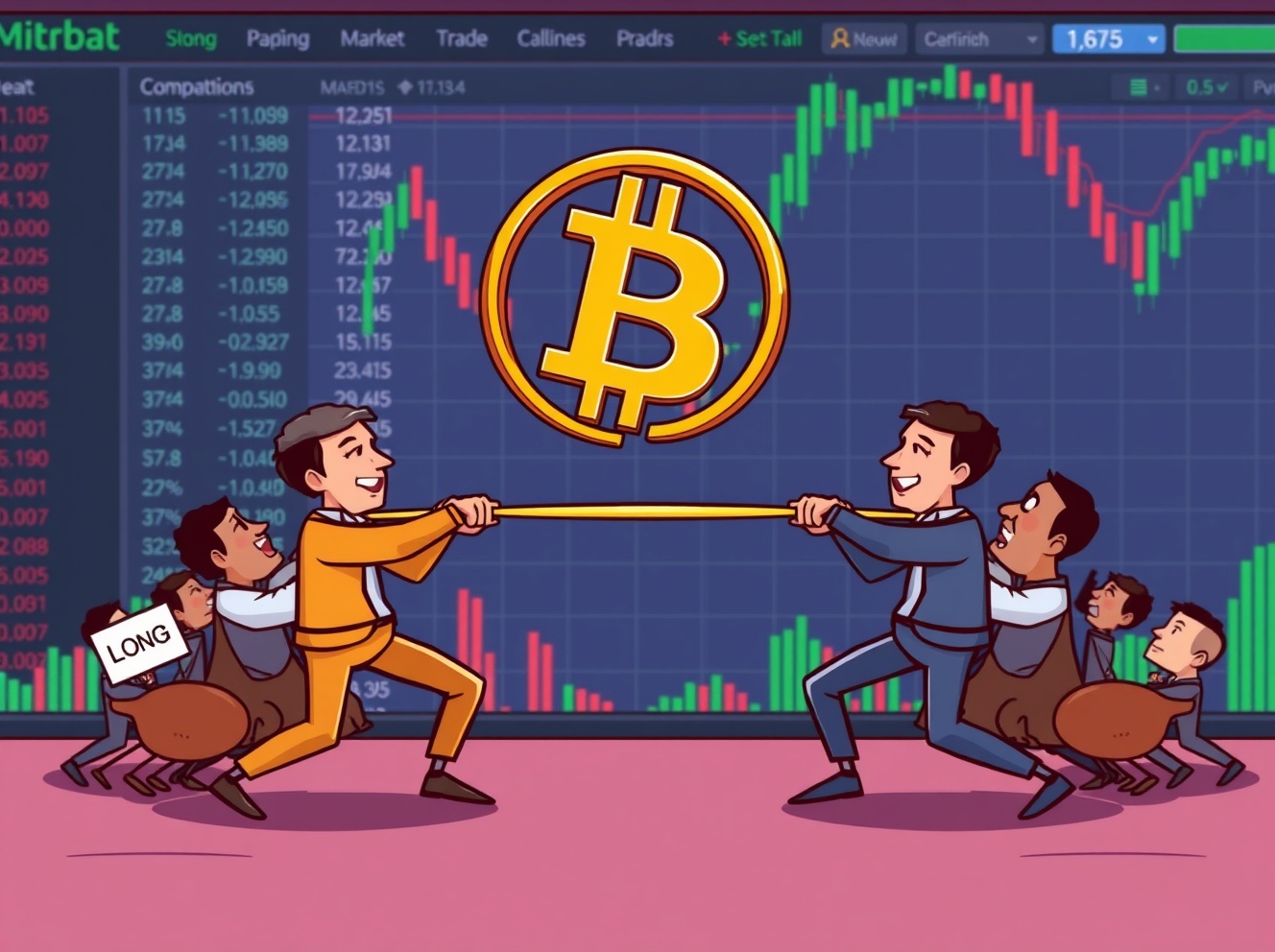BitcoinWorld

Bitcoin Long-Short Ratio: Crucial Insights from 24-Hour Futures Data
In the fast-paced world of cryptocurrency, understanding market sentiment is as crucial as analyzing price charts. While Bitcoin’s volatility can be exhilarating, it also presents challenges for traders. One powerful tool to gauge the collective mood of the market is the Bitcoin long-short ratio. This metric offers a unique window into how traders are positioning themselves on major exchanges, providing insights that can help inform your own trading decisions.
What Exactly is the Bitcoin Long-Short Ratio and Why Does It Matter?
Before diving into the numbers, let’s clarify what the Bitcoin long-short ratio represents. In essence, it’s a measure of the number of long positions (bets on price increase) versus short positions (bets on price decrease) for a specific asset, in this case, Bitcoin, on perpetual futures contracts. Perpetual futures are a type of derivative that allows traders to speculate on the future price of an asset without an expiry date, mimicking spot market trading while offering leverage.
The ratio is calculated by dividing the total number of long positions by the total number of short positions. A ratio greater than 1 suggests more traders are bullish (long), while a ratio less than 1 indicates a bearish sentiment (more short positions). For example, if the ratio is 1.5, it means there are 1.5 long positions for every 1 short position. Conversely, if it’s 0.7, there are 0.7 long positions for every 1 short position.
Why is this ratio so important?
- Sentiment Indicator: It directly reflects the prevailing sentiment among derivatives traders, who often lead price movements in the spot market.
- Potential Reversals: Extreme ratios can sometimes signal potential market reversals. For instance, an overwhelmingly high long ratio might suggest over-optimism, making the market ripe for a correction.
- Liquidation Risks: Understanding the distribution of positions can help assess potential cascading liquidations if the price moves sharply against the majority.
Decoding the Latest 24-Hour Bitcoin Long-Short Ratio Trends: A Closer Look
Now, let’s examine the recent 24-hour Bitcoin long-short ratio data for BTC perpetual futures across some of the industry’s leading exchanges. This snapshot provides a real-time glimpse into the collective positioning of millions of traders.
| Exchange | Long % | Short % |
|---|---|---|
| Total Across Sampled Exchanges | 47.96% | 52.04% |
| Binance | 46.76% | 53.24% |
| Bybit | 47.4% | 52.6% |
| Gate.io | 51.79% | 48.21% |
The aggregated data reveals a slight lean towards short positions, with 52.04% of the total positions being short, compared to 47.96% long. This indicates that, on average, more traders were betting on a downward price movement for Bitcoin over the past day.
Individual Exchange Insights:
- Binance: As one of the largest crypto exchanges globally, Binance’s data often sets the tone. Here, the sentiment is distinctly bearish, with shorts outnumbering longs at 53.24% to 46.76%. This suggests a cautious or pessimistic outlook among a significant portion of Binance traders.
- Bybit: Similarly, Bybit’s ratios align closely with Binance, showing a slightly higher proportion of short positions (52.6% short vs. 47.4% long). This reinforces the general bearish sentiment observed across major platforms.
- Gate.io: Interestingly, Gate.io presents a contrasting picture. Here, long positions slightly outweigh short positions (51.79% long vs. 48.21% short). This divergence could be due to a different user demographic, regional sentiment, or specific trading strategies prevalent on this exchange. It highlights the importance of looking at data from multiple sources rather than relying on a single one.
Are Traders Leaning Bullish or Bearish? Interpreting the Bitcoin Long-Short Ratio
The overall market sentiment, as indicated by the aggregated Bitcoin long-short ratio, suggests a cautious to bearish outlook among futures traders over the last 24 hours. The fact that the majority of positions are short implies that many traders anticipate a potential dip in Bitcoin’s price, or are at least hedging against one.
However, it’s vital to interpret these numbers with nuance. A slight bearish lean, as seen in the overall data, isn’t necessarily a strong signal for a massive price drop. It could simply reflect short-term profit-taking or a reaction to recent price action. The real insights often come from extreme deviations or rapid shifts in the ratio.
For example, if the long ratio were to surge to 70-80% while the price remains stagnant or drops, it could indicate an over-leveraged bullish market, potentially setting the stage for a significant liquidation cascade if the price moves unfavorably. Conversely, an extreme short ratio might suggest an oversold market, where a bounce could be imminent as short positions get squeezed.
The contrasting sentiment on Gate.io is particularly noteworthy. While Binance and Bybit traders lean bearish, Gate.io’s bullish tilt could signify differing expectations or even a contrarian play by a segment of the market. This kind of divergence can sometimes precede significant moves if one side proves to be more accurate or dominant in the coming hours.
How Can You Use Bitcoin Long-Short Ratio Data in Your Trading Strategy?
Integrating Bitcoin long-short ratio data into your trading strategy can provide a valuable edge, but it should never be your sole indicator. Here’s how you can leverage this information:
- Confluence with Other Indicators: Use the ratio to confirm signals from other technical analysis tools. If your chart analysis suggests a potential downtrend, and the long-short ratio shows a strong bearish bias, it adds confidence to your short position.
- Identifying Overextension: Look for extreme ratios. An unusually high long ratio might suggest that the market is overly optimistic and due for a correction, offering a potential short entry. Conversely, an extremely low long ratio could signal peak pessimism, potentially preceding a bounce.
- Spotting Divergences: Pay attention when the ratio moves contrary to price action. For instance, if Bitcoin’s price is rising, but the long-short ratio is decreasing (more shorts opening), it could indicate a lack of conviction in the rally and a potential reversal.
- Risk Management: The ratio can help you gauge the overall risk in the market. If the majority of traders are heavily leveraged in one direction, the potential for volatile price swings due to liquidations increases. Adjust your position sizes accordingly.
- Understanding Market Structure: By observing which exchanges have higher long or short percentages, you can gain insights into the varying market structures and participant behaviors across platforms.
Remember, the Bitcoin long-short ratio is a dynamic metric that changes constantly. Regular monitoring is key to extracting timely insights.
Challenges and Nuances: What the Bitcoin Long-Short Ratio Doesn’t Tell You
While powerful, the Bitcoin long-short ratio isn’t a crystal ball. There are several limitations and nuances to consider:
- Whale Activity: The ratio doesn’t differentiate between retail traders and large institutional players (whales). A few large positions can significantly skew the ratio, making it appear as if the broader market holds a certain sentiment when it’s primarily driven by a handful of entities.
- Leverage Levels: The ratio only tells you the number of long vs. short positions, not the leverage used. A high number of long positions with low leverage might pose less risk than fewer positions with extremely high leverage.
- Data Lag and Source: Data can vary slightly between aggregators and exchanges due to different methodologies or reporting times. Always consider the source and potential for minor discrepancies.
- Not a Standalone Indicator: Relying solely on the long-short ratio for trading decisions is risky. It’s a sentiment indicator and should always be used in conjunction with price action, volume analysis, order book depth, and other fundamental and technical indicators.
- Market Manipulation: In some cases, large players might intentionally open positions to influence the ratio, aiming to trap unsuspecting traders.
In conclusion, the Bitcoin long-short ratio offers a fascinating lens through which to view market sentiment in the highly volatile world of cryptocurrency. The latest 24-hour data suggests a cautious, slightly bearish stance among most BTC perpetual futures traders, with notable exceptions like Gate.io. While not a definitive predictor, understanding these dynamics provides crucial context for your trading strategy. By combining this valuable insight with other forms of analysis and maintaining a robust risk management approach, traders can navigate the crypto markets with greater confidence and precision. Always remember that successful trading is about making informed decisions, not just following a single indicator.
Frequently Asked Questions (FAQs)
What is a long-short ratio in crypto futures?
A long-short ratio in crypto futures measures the proportion of open long positions (bets on price increase) to open short positions (bets on price decrease) for a specific cryptocurrency, like Bitcoin, on derivatives exchanges. It’s a key indicator of market sentiment.
How is the Bitcoin long-short ratio calculated?
The Bitcoin long-short ratio is typically calculated by dividing the total number of long positions by the total number of short positions on a given exchange or across multiple exchanges for BTC perpetual futures contracts.
Why is the long-short ratio important for traders?
It’s important because it reflects the collective sentiment of futures traders, who often lead price movements. Extreme ratios can signal potential market reversals, while shifts in the ratio can confirm trends or indicate divergences, providing valuable context for trading decisions.
Does a high short ratio always mean Bitcoin price will fall?
Not necessarily. While a high short ratio indicates bearish sentiment, it doesn’t guarantee a price fall. Sometimes, an extremely high short ratio can lead to a ‘short squeeze,’ where a small price increase forces short sellers to buy back, driving the price up rapidly.
Which exchanges provide reliable long-short ratio data?
Major cryptocurrency derivatives exchanges like Binance, Bybit, OKX, Huobi, and Gate.io often provide their own long-short ratio data. Aggregators also compile data from multiple exchanges to give a broader market view.
How often is the Bitcoin long-short ratio updated?
The Bitcoin long-short ratio is a dynamic metric that updates frequently, often in real-time or every few minutes, depending on the data provider or exchange. Traders usually monitor it continuously for timely insights.
If you found this deep dive into Bitcoin long-short ratios insightful, consider sharing this article with your fellow traders and crypto enthusiasts on social media. Your shares help us continue providing valuable market analysis!
To learn more about the latest crypto market trends, explore our article on key developments shaping Bitcoin price action.
This post Bitcoin Long-Short Ratio: Crucial Insights from 24-Hour Futures Data first appeared on BitcoinWorld and is written by Editorial Team





